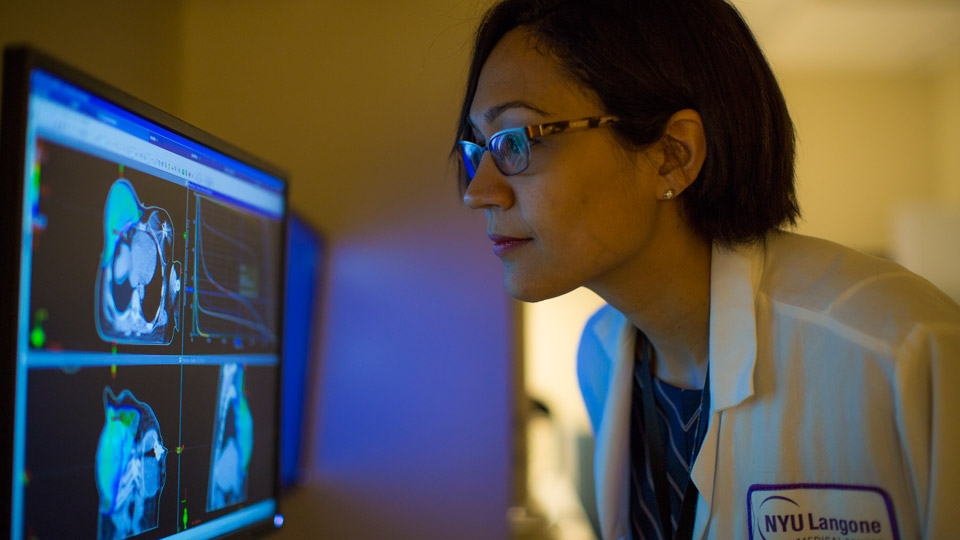Radiation Therapy for Breast Cancer
At NYU Langone’s Perlmutter Cancer Center, doctors may use radiation therapy, which uses high-energy beams that kill cancer cells, to treat women with breast cancer. Our radiation oncologists are highly specialized in treating breast cancer.
Radiation Therapy After Breast-Conserving Surgery
Radiation therapy is most often used to prevent cancer from returning after breast-conserving surgery, also called a lumpectomy.
Radiation therapy after lumpectomy is used to reduce the risk of cancer coming back. Studies have shown that lumpectomy and radiation therapy, called breast conservation therapy, is as effective as a mastectomy in patients with early-stage breast cancer.
Our doctors most frequently recommend external beam radiation therapy. This type of radiation therapy is delivered by a machine called a linear accelerator. The machine rotates around you during therapy to treat the entire breast.
Clinical Trials
You may be a candidate for clinical trials that test advanced treatments for breast cancer.
Learn MoreOur doctors may recommend whole breast irradiation—a type of radiation therapy that is targeted to the entire breast—or partial breast irradiation, which is delivered only to the part of the breast affected by cancer.
Whole breast irradiation is typically delivered over the course of three weeks. Some people receiving whole breast irradiation also require an additional week of radiation therapy specifically targeted to the location of the tumor. This may be given at the same time as whole breast irradiation.
Accelerated partial breast irradiation is typically offered to women who have an early breast cancer diagnosis and are postmenopausal. Partial breast irradiation is typically delivered in one week.
If cancer has also spread to the lymph nodes, doctors may recommend radiation therapy targeted to the breast and lymph nodes, which is given over five to six weeks.
Radiation Therapy After Mastectomy
Radiation therapy may also be recommended after a mastectomy for women with cancer in the lymph nodes and who may have other high-risk factors to reduce the chance of the cancer returning.
Radiation therapy is directed at the reconstructed breast or the chest wall and the lymph node basins—the area where the nodes were surgically removed. Post-mastectomy radiation therapy typically takes five to six weeks.
Our experts ensure that the radiation therapy is delivered as precisely as possible. If you are receiving external beam radiation therapy, you are not radioactive in any way and do not need to limit contact with children or pregnant women.
Radiation Treatment Planning
Our radiation oncologists use CT scans of the target area and surrounding tissue and organs in conjunction with computer software to develop a customized treatment plan for you. This software creates a three-dimensional image of the target tissue and surrounding organs, and allows our doctors to determine how best to target the cancer while sparing as much nearby healthy tissue as possible. A radiation plan is designed specifically for you based on the location and type of tumor, the extent of the cancer, and your anatomy.

Our doctors may perform X-rays or CT scans during treatments to ensure that the radiation therapy is targeting the breast cancer and avoiding healthy tissue. This approach, called image-guided radiation therapy, helps compensate for organs moving during treatments, which may require an adjustment in radiation targeting. The technique also enables doctors to track the size and shape of the tumor over the course of treatment.
Prone Position External Beam Radiation Therapy
Perlmutter Cancer Center radiation oncologists helped pioneer prone external beam radiation therapy, which allows for better distribution of the treatment dose. During this approach, you lie in a prone position, or face down, rather than on your back, called the supine position.
Our doctors helped pioneer prone external beam radiation therapy, which allows for better targeting of the treatment dose while avoiding nearby organs, such as the heart or lungs.
This positioning lets gravity displace the breast tissue away from the body, allowing radiation oncologists to better target the breast tissue while avoiding the heart and lungs.
Another advantage of the prone position is that it decreases the incidence of skin irritation. Radiation beams are evenly distributed throughout the breast and are less concentrated in the skin folds, as compared to radiation therapy given to women when they lie on their backs during treatment.
Whole breast radiation and partial breast radiation are typically delivered while you are in the prone position. After mastectomy, the supine, or back-lying position, is used for better targeting of the lymph nodes surrounding a tumor.
Deep Inspiratory Breath Hold
Deep inspiratory breath hold may be used in women with left-sided breast cancer who are treated in the supine position. In this therapy, you hold your breath so that the heart moves away from the left breast, minimizing the radiation dose to the heart and lungs. Delivery of the radiation beam is controlled by breathing.
Managing Side Effects
The most common side effects of radiation therapy for breast cancer are mild fatigue, skin darkening or reddening—much like a sunburn—and breast pain, discomfort, or sensitivity. These symptoms tend to be mild and build up over the course of treatment, peaking during the last week of radiation or the week after therapy ends. Doctors can prescribe topical skin creams to help manage these effects. They can also refer you to our support services and to Perlmutter Cancer Center’s integrative health services.
Serious side effects, such as heart or lung damage, are rare due to the use of radiation techniques such as prone breast irradiation and deep inspiratory breath hold, as well as CT-based radiation treatment planning.
Meet Our Doctors
Perlmutter Cancer Center specialists provide care and support during treatment.
Browse Doctors